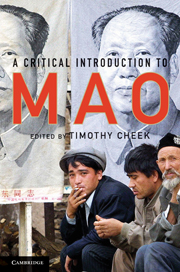Book contents
- Frontmatter
- Contents
- List of Illustrations
- About the Contributors
- Preface
- Acknowledgments
- Timeline of Twentieth-Century China
- Maps
- Part I Mao's World
- 1 Mao, Revolution, and Memory
- 2 Making Revolution in Twentieth-Century China
- 3 From Urban Radical to Rural Revolutionary: Mao From the 1920s to 1937
- 4 War, Cosmopolitanism, and Authority: Mao from 1937 to 1956
- 5 Consuming Fragments of Mao Zedong: The Chairman's Final Two Decades at the Helm
- 6 Mao and His Followers
- 7 Mao, Mao Zedong Thought, and Communist Intellectuals
- 8 Gendered Mao: Mao, Maoism, and Women
- 9 Mao the Man and Mao the Icon
- Part II Mao's Legacy
- Appendix: Selected Further Readings (Annotated)
- Index
- References
4 - War, Cosmopolitanism, and Authority: Mao from 1937 to 1956
Published online by Cambridge University Press: 05 August 2012
- Frontmatter
- Contents
- List of Illustrations
- About the Contributors
- Preface
- Acknowledgments
- Timeline of Twentieth-Century China
- Maps
- Part I Mao's World
- 1 Mao, Revolution, and Memory
- 2 Making Revolution in Twentieth-Century China
- 3 From Urban Radical to Rural Revolutionary: Mao From the 1920s to 1937
- 4 War, Cosmopolitanism, and Authority: Mao from 1937 to 1956
- 5 Consuming Fragments of Mao Zedong: The Chairman's Final Two Decades at the Helm
- 6 Mao and His Followers
- 7 Mao, Mao Zedong Thought, and Communist Intellectuals
- 8 Gendered Mao: Mao, Maoism, and Women
- 9 Mao the Man and Mao the Icon
- Part II Mao's Legacy
- Appendix: Selected Further Readings (Annotated)
- Index
- References
Summary
To call Hitler evil may well be true and morally satisfying. But it explains nothing.
Ian Kershaw, Hitler: 1936–1945 Nemesis, p. xvii.On November 29, 1937, a Soviet plane landed in a blizzard in Yan'an, the communist capital in the northern Shaanxi wasteland. On board were Peter Vladimirov, Moscow's new representative to the Chinese Communist Party (CCP); Kang Sheng, the CCP Central Committee's representative to the Communist International (Comintern), who would go down in history as the Chinese communists' most loathsome spy chief; and Chen Yun, the architect of the post-Mao economic reforms and at the time the Central Committee's representative to Xinjiang warlord Sheng Shicai.
The most important passenger was Wang Ming (alias Chen Shaoyu), who had been in Moscow since 1931. The mission's arrival meant the beginning of a struggle for power between Wang, representing an internationalist Moscow-oriented tendency in the CCP, and Mao Zedong, calling for the Sinification of revolution. Mao would prevail before a year had passed, but he focused a good part of his attention in the remaining years of World War II on wringing Wang Ming–type communist cosmopolitanism from the CCP. World War I had generated powerful opportunities for globalizing forces because its horrors had led to widespread disenchantment with bourgeois-dominated nation-states. World War II shut down these opportunities while arming national liberation movements. In transforming the CCP during the 1937–45 Sino-Japanese War from a defeated, demoralized, and divided party oriented toward Moscow into an organization with a strong ethos, a clear sense of a separate Chinese identity, and a powerful army, Mao domesticated, militarized, and nationalized revolution in China.
- Type
- Chapter
- Information
- A Critical Introduction to Mao , pp. 87 - 109Publisher: Cambridge University PressPrint publication year: 2010
References
- 1
- Cited by

